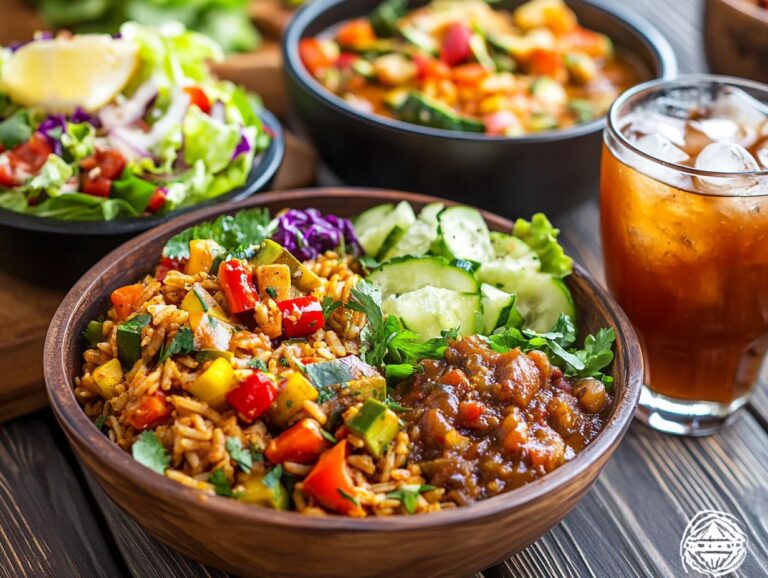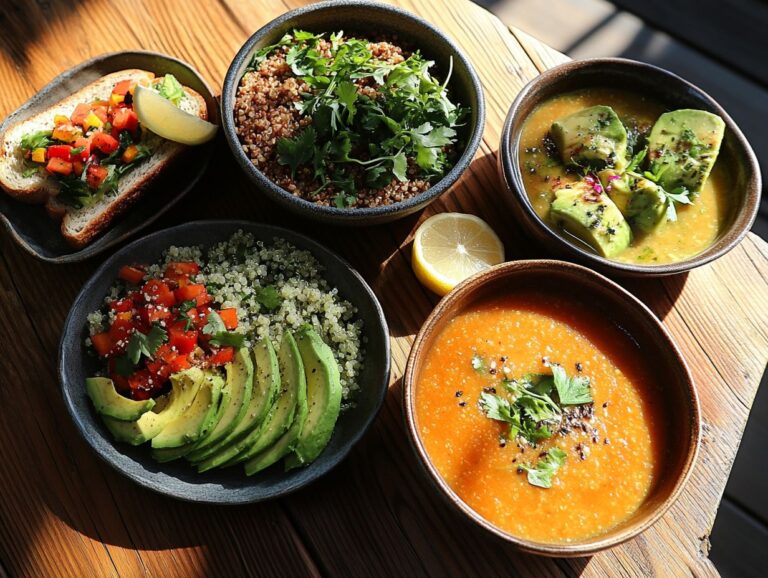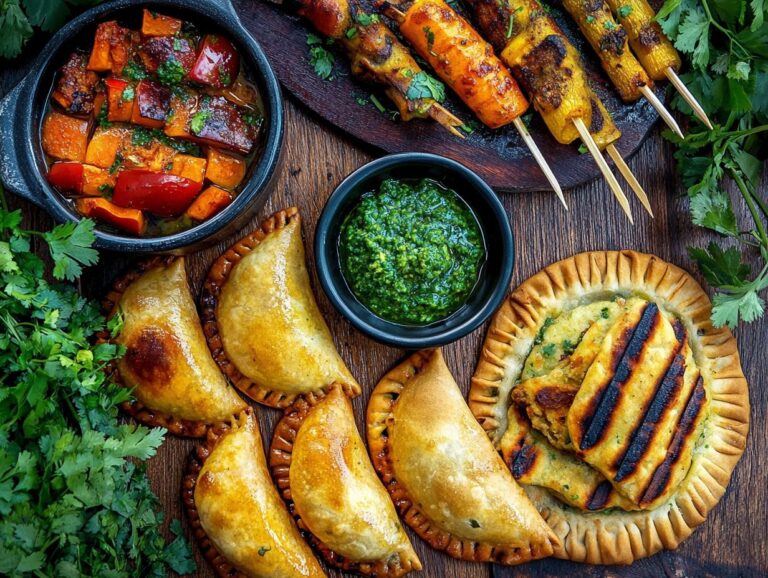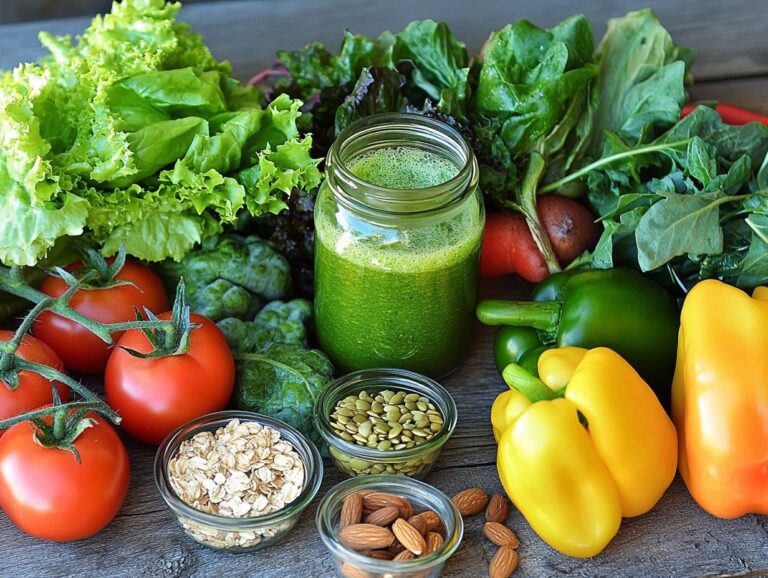Homemade vegan baking offers a multitude of delicious possibilities, and using a bread machine can make the process simple and enjoyable. Whether you are an experienced baker or a curious beginner, this guide will help you select the right bread machine and ingredients to embark on your baking journey. From a basic vegan bread recipe to enticing variations, you will learn how to create both sweet and savory delights. Additionally, you will find tips to troubleshoot common issues, ensuring that your baking experience is as perfect as possible. Get ready to embrace the joy of making homemade vegan treats!
Benefits of Homemade Vegan Baking
Homemade vegan baking offers control over ingredients, encourages healthy eating habits, and fosters creativity with flavor and food combinations. When baked goods are prepared at home instead of being manufactured by large corporations, there are typically fewer preservatives and unhealthy additives, allowing for a focus on basic ingredients such as flour, water, and plant-based oils.
In a home kitchen, a variety of flavorings, sweeteners, and toppings can cater to diverse dietary preferences. Preparing delicious vegan recipes together can be a fun family meal prep activity, enabling everyone to enjoy healthy snacks tailored to their tastes. Easy-to-make and customizable recipes enhance the enjoyment of the baking process while contributing to its overall benefits.
Some simple vegan baking recipes that can be made at home include:
- Artisan bread
- Quick bread
- Energy bars
- Healthier dessert options
Artisan bread allows for the inclusion of various whole grains and seeds, which enhances the nutrient profile of meals. Whole grains provide fiber while seeds offer healthy oils, contributing to overall well-being.
Quick breads, such as banana or zucchini bread, are a delightful way to incorporate fruits and vegetables into snacks. These sweet or savory loafs, muffins, or pancakes can be prepared and baked in under an hour.
Energy bars, which are often purchased pre-packaged, can contain high amounts of sugar and preservatives. In contrast, homemade energy bars can serve as delicious alternatives to energy drinks. They can be made using oats and flour, along with a variety of nuts, seeds, fruits, and natural sweeteners, resulting in a healthy, filling, and nutrient-dense snack that is easy to carry.
Desserts are frequently viewed with guilt by those trying to maintain a healthy diet. However, simple and quick desserts can be crafted from everyday ingredients, ranging from healthy energy bars to fruit-based treats. These recipes can be customized with various spices, toppings, and sauces, allowing for creative experimentation while ensuring they remain healthy and vegan.
|||
Benefits of Homemade Vegan Baking
Homemade vegan baking offers control over ingredients, encourages healthy eating habits, and fosters creativity with flavor and food combinations. When baked goods are prepared at home instead of being manufactured by large corporations, there are typically fewer preservatives and unhealthy additives, allowing for a focus on basic ingredients such as flour, water, and plant-based oils.
In a home kitchen, a variety of flavorings, sweeteners, and toppings can cater to diverse dietary preferences. Preparing delicious vegan recipes together can be a fun family meal prep activity, enabling everyone to enjoy healthy snacks tailored to their tastes. Easy-to-make and customizable recipes enhance the enjoyment of the baking process while contributing to its overall benefits by offering great breakfast ideas.
Some simple vegan baking recipes that can be made at home include:
- Artisan bread
- Quick bread
- Energy bars
- Healthier dessert options
Artisan bread allows for the inclusion of various whole grains and seeds, which enhances the nutrient profile of meals. Whole grains provide fiber while seeds offer healthy oils, contributing to overall well-being.
Quick breads, such as banana or zucchini bread, are a delightful way to incorporate fruits and vegetables into snacks. These sweet or savory loafs, muffins, or pancakes can be prepared and baked in under an hour.
Energy bars, which are often purchased pre-packaged, can contain high amounts of sugar and preservatives. In contrast, homemade energy bars can serve as delicious alternatives to energy drinks. They can be made using oats and flour, along with a variety of nuts, seeds, fruits, and natural sweeteners, resulting in a healthy, filling, and nutrient-dense snack that is easy to carry.
Desserts are frequently viewed with guilt by those trying to maintain a healthy diet. However, simple and quick desserts can be crafted from everyday ingredients, ranging from healthy energy bars to fruit-based treats. These recipes can be customized with various spices, toppings, and sauces, allowing for creative experimentation while ensuring they remain healthy and vegan.
Homemade vegan baking offers control over ingredients, encourages healthy eating habits, and fosters creativity with flavor and food combinations. When baked goods are prepared at home instead of being manufactured by large corporations, there are typically fewer preservatives and unhealthy additives, allowing for a focus on basic ingredients such as flour, water, and plant-based oils.
In a home kitchen, a variety of flavorings, sweeteners, and toppings can cater to diverse dietary preferences. Preparing delicious vegan recipes together can be a fun family meal prep activity, enabling everyone to enjoy healthy snacks tailored to their tastes. Easy-to-make and customizable recipes enhance the enjoyment of the baking process while contributing to its overall benefits.
Some simple vegan baking recipes that can be made at home include:
- Artisan bread
- Quick bread
- Energy bars
- Healthier dessert options
Artisan bread allows for the inclusion of various whole grains and seeds, which enhances the nutrient profile of meals. Whole grains provide fiber while seeds offer healthy oils, contributing to overall well-being.
Quick breads, such as banana or zucchini bread, are a delightful way to incorporate fruits and vegetables into snacks. These sweet or savory loafs, muffins, or pancakes can be prepared and baked in under an hour.
Energy bars, which are often purchased pre-packaged, can contain high amounts of sugar and preservatives. In contrast, homemade energy bars can serve as delicious alternatives to energy drinks. They can be made using oats and flour, along with a variety of nuts, seeds, fruits, and natural sweeteners, resulting in a healthy, filling, and nutrient-dense snack that is easy to carry.
Desserts are frequently viewed with guilt by those trying to maintain a healthy diet. However, simple and quick desserts can be crafted from everyday ingredients, ranging from healthy energy bars to fruit-based treats. These recipes can be customized with various spices, toppings, and sauces, allowing for creative experimentation while ensuring they remain healthy and vegan.
Getting Started with a Bread Machine and Bread Machine Recipes
A bread machine simplifies the process of homemade baking and enhances the quality of bread, allowing for the effortless preparation of various types with minimal effort. It automates tasks such as kneading, rising time, and baking, which would typically require hours of attention and labor, making the process quicker and more convenient for busy individuals.
With the right appliances and a basic understanding of essential baking tools, anyone can create a range of breads, from crusty loaves to soft varieties, using everyday ingredients like flour, yeast, water, and salt.
Understanding how your bread machine functions is crucial for mastering the different cooking methods that can elevate your baking skills.
Choosing the Right Machine and Ingredients
Choosing the right bread machine and ingredients is essential for achieving the perfect loaf of bread, whether gluten-free or regular. A simple bread machine can be a great investment for anyone interested in bread machine recipes.
Key features to consider include capacity, kneading ability, and the management of rise and bake time and temperature for different types of bread. Many machines also offer programmable settings that enhance the user experience by allowing adjustments in crust color and loaf size.
Regarding ingredients, using high-quality products, such as organic flour or natural sweeteners, can significantly affect the final results. Additionally, making ingredient substitutions is crucial—for instance, using almond milk instead of regular milk for those who are lactose intolerant, or adding seeds to boost nutritional value.
Basic Vegan Bread Recipe
A basic vegan bread recipe is easy to prepare and can be quite satisfying, allowing you to enjoy fresh, homemade bread that aligns with your dietary needs.
This simple recipe incorporates essential ingredients such as flour, yeast, water, and salt, along with sugar to feed and activate the yeast, and olive oil for added flavor and moisture. These basic ingredients are fundamental in plant-based baking.
The resulting bread boasts a delightful texture and taste, and the recipe can be easily modified or adapted to create different types of bread by incorporating various ingredients.
Ingredients and Step-by-Step Instructions
Basic vegan bread is a simple and easy recipe that serves as an excellent source of energy. Bread is one of the most widely consumed foods globally, acting as a staple for a significant portion of the population, even in some of the poorest regions. It provides a convenient and affordable means of obtaining energy and nutrition.
To bake your basic vegan bread, you need to carefully select your ingredients and follow precise, step-by-step instructions. The key ingredients for basic vegan bread include:
- Flour: Bread flour and all-purpose flour are the most commonly used types. Bread flour has a higher protein content, which aids in gluten development, resulting in a lighter, airier bread. Whole wheat flour and gluten-free flour can also be used for different dietary preferences.
- Yeast: Yeast is essential for bread-making. The most commonly used types are active dry yeast and instant yeast. Active dry yeast requires proofing before use, whereas instant yeast can be used directly and tends to rise faster.
- Water: Water is crucial for achieving the right consistency in the bread mixture and regulating the temperature for yeast activation. The choice of water can also affect the bread’s texture. Tap water is generally acceptable, but some bakers prefer filtered or bottled water for enhanced taste and texture.
- Salt: Salt not only enhances the flavor of the bread but also helps the yeast perform better and acts as a preservative.
- Sugar: Sugar aids yeast activity and provides energy, although it is not necessary for all bread recipes. Baking powder is another ingredient that can be used in quick bread recipes.
- Olive Oil: Adding a few tablespoons of olive oil or other vegetable oils contributes a richer flavor to the bread.
The amount of each ingredient will depend on the portion size of the bread you are making. The mixing technique also affects the bread’s consistency. All ingredients should be mixed properly, with dry ingredients combined in one bowl and wet ingredients added later. This is a fundamental step in vegan recipes.
Kneading is a crucial phase that develops the gluten structure in the bread dough, allowing it to expand when baked. Achieving the right balance of flour and water is essential for a smooth, elastic dough. Too little flour will make the dough sticky and difficult to shape, while too much flour will cause it to crumble and fail to rise properly.
The standard kneading technique involves pushing the dough away, folding it back, turning it 90 degrees, and repeating this process for 10-20 minutes until the dough becomes elastic and springs back when poked.
Rising time significantly impacts the texture of the bread, so it must be closely monitored. Place the bread dough in a warm room to rise, ideally at a temperature between 75-80 degrees Fahrenheit. The rising duration can vary based on the type of yeast used, the room temperature, and the specific recipe, ranging anywhere from 30 minutes to 3 hours. Understanding these baking techniques is crucial for successful homemade baking.
After the first rise, gently punch down the dough to promote a richer flavor. Shape it into a loaf, place it in a baking pan, cover it, and allow it to rise for another 30 minutes to an hour. Bake the bread in a preheated oven; while temperatures vary by recipe, 375 degrees Fahrenheit is a common setting. Baking times will also differ, but basic vegan bread typically bakes for 30-35 minutes or until the top is golden brown and sounds hollow when tapped on the bottom. Adjusting baking settings as per your machine’s instructions can help you achieve the perfect loaf.
Once removed from the oven, allow the bread to cool on a wire rack, and refrain from cutting into it until it has cooled completely to ensure proper cooking. Following these recipe instructions carefully will help you achieve the best results.
Variations and Additions to the Basic Recipe
Exploring variations and additions to your basic vegan bread recipe can lead to new flavors and textures, enhancing your homemade baking experience.
Whether you want to experiment with different types of bread, such as sourdough or whole wheat, or incorporate seasonal ingredients for a special touch, the possibilities are endless.
You can also add toppings like seeds or herbs to elevate the flavor profiles of your bread, resulting in unique and delicious variations that cater to various tastes and occasions.
|||
Variations and Additions to the Basic Recipe
Exploring variations and additions to your basic vegan bread recipe can lead to new flavors and textures, enhancing your homemade baking experience.
Whether you want to experiment with different types of bread, such as sourdough or whole wheat, or incorporate seasonal ingredients for a special touch, the possibilities are endless. You can also try no-knead bread recipes to save time.
You can also add toppings like seeds or herbs to elevate the flavor profiles of your bread, resulting in unique and delicious variations that cater to various tastes and occasions.
Exploring variations and additions to your basic vegan bread recipe can lead to new flavors and textures, enhancing your homemade baking experience.
Whether you want to experiment with different types of bread, such as sourdough or whole wheat, or incorporate seasonal ingredients for a special touch, the possibilities are endless.
You can also add toppings like seeds or herbs to elevate the flavor profiles of your bread, resulting in unique and delicious variations that cater to various tastes and occasions.
Sweet and Savory Options
When making homemade vegan bread, both sweet and savory options can be equally delicious and suitable for various meal ideas.
Sweet varieties can incorporate ingredients like dried fruits or chocolate chips to enhance a basic loaf. On the other hand, savory breads can include herbs, garlic, or even vegan cheese, resulting in a flavorful option perfect for healthy snacks or as a base for hearty sandwiches.
Experimenting with different flavors can significantly enhance the enjoyment of plant-based bread. For example, spices like cinnamon can be added to sweet varieties, while smoked paprika can elevate savory recipes.
|||
Sweet and Savory Options
When making homemade vegan bread, both sweet and savory options can be equally delicious and suitable for various meal ideas.
Sweet varieties can incorporate ingredients like dried fruits or chocolate chips to enhance a basic loaf. On the other hand, savory breads can include herbs, garlic, or even vegan cheese, resulting in a flavorful option perfect for healthy snacks or as a base for hearty sandwiches. Using whole foods and plant-based ingredients ensures that your bread remains healthy and nutritious.
Experimenting with different flavors can significantly enhance the enjoyment of plant-based bread. For example, spices like cinnamon can be added to sweet varieties, while smoked paprika can elevate savory recipes. This experimentation is part of the joy of culinary techniques.
When making homemade vegan bread, both sweet and savory options can be equally delicious and suitable for various meal ideas.
Sweet varieties can incorporate ingredients like dried fruits or chocolate chips to enhance a basic loaf. On the other hand, savory breads can include herbs, garlic, or even vegan cheese, resulting in a flavorful option perfect for healthy snacks or as a base for hearty sandwiches.
Experimenting with different flavors can significantly enhance the enjoyment of plant-based bread. For example, spices like cinnamon can be added to sweet varieties, while smoked paprika can elevate savory recipes.
Those with nut allergies can substitute nuts with seeds such as chia or flax, and individuals seeking gluten-free options can use almond or coconut flour instead of regular flour. This approach to ingredient substitutions can greatly enhance vegan recipes, making them accessible to more people.
This approach not only increases the accessibility of homemade bread but also maintains delicious flavors and textures, contributing to the variety of bread machine recipes available to vegan lifestyle enthusiasts.
Other Vegan Baked Goods to Make in a Bread Machine
A bread machine can produce a wide range of vegan products beyond just bread, making it an essential tool for homemade baking and preparing plant-based recipes.
Along with various types of bread, it can also make pizza dough, buns, and rolls, providing easy vegan bread options for those exploring different bread types and recipe variations.
Furthermore, a bread machine can be used to prepare flatbreads and, in some cases, even cakes, allowing for the creation of soft bread and quick bread, perfect for breakfast ideas and healthy snacks.
Pizza Dough, Cakes, and More
Pizza dough, cakes, rolls, and buns are all meal ideas that can be easily prepared using a bread machine. Making pizza dough in a bread machine is just as straightforward as making regular bread; the machine effectively develops the flour and yeast, producing a pizza base that’s ready for your favorite toppings.
Similarly, cakes can be baked in a bread machine with the same ease as traditional bread, provided you choose the right recipes for optimal results. Rolls and buns can also be made effortlessly in a bread machine, just like regular bread.
Selecting the appropriate flours for your pizza and cake recipes can significantly impact the final product. For instance, using bread flour creates a chewier pizza crust, while a combination of all-purpose and whole wheat flour yields a heartier base.
When making cakes, it’s important to choose mixes that maintain a good balance of wet and dry ingredients, utilizing baking powder appropriately, and do remember to adjust the baking times accordingly.
Additionally, you can enhance your pizza, cakes, rolls, and buns with various add-ins, such as seeds, nuts, fruits, or chocolate chips, to add flavor and texture, creating artisan bread and unique homemade treats that reflect your food creativity.
Troubleshooting Common Bread Machine Issues
Understanding common bread machine problems and their solutions is essential for achieving perfect bread and ensuring successful baking. Many amateur bakers encounter issues such as insufficient rising, inconsistent bread textures, or over-baked loaves.
Fortunately, these problems can often be resolved with some helpful baking tips. By addressing common pitfalls, such as incorrect measurements of flour or yeast, and learning how to adjust baking time and temperature appropriately, you can enhance your skills and achieve better results with your bread machine.
Tips for Perfect Baking Every Time
Perfect baking requires a few essential tips that can significantly enhance the quality of your bread and baked goods. These tips include setting the oven correctly, understanding how temperature control impacts baking, ensuring accurate portion sizes for the desired bread texture, and making appropriate ingredient substitutions.
Do You Need to Adjust Temperature Settings?
A great way to learn about temperature control is by investing in an oven thermometer. Built-in thermometers can often be inaccurate, so this small investment can help guarantee that you are baking at the correct temperature.
No-Bake Bread: Importance of Portion Size
The significance of measuring accurate portion sizes cannot be overstated. Using a kitchen scale to properly measure ingredients is crucial in preventing over- or under-baking, ensuring that your baked goods are consistently delicious.
Do You Need to Adjust Ingredients?
Feel free to experiment with different types of flours or natural sweeteners. However, it is important to adjust the amount of liquid added to accommodate these changes, as variations can affect the moisture content of the dough.




